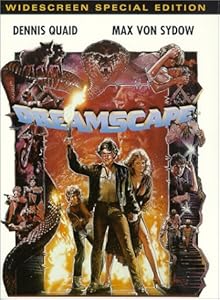 Cover of Dreamscape
Cover of DreamscapeOf course, there was far more going on than that. Well, sort of. Dennis Quaid is a rebellious bad-boy psychic forcefully recruited by Max Von Sydow and his sexpot assistant to become a psychic interloper in the dream world. Normally aloof Quaid is quickly converted into selfless dream protector by a kid in a wheelchair with bad dreams, but things get complicated when President (of the United States of America) Eddie Albert comes to the facility because of the horrific nightmares of nuclear destruction that have been keeping him up nights. It turns out that Sydow’s old buddy Christopher Plummer is a really powerful shadow-government official that wants to stop the resident from deactivating America’s nuclear stockpile by having Patricidal Sociopathic Psychic David Patrick Kelly kill him in his dream. Can Quaid and Capshaw save the President and the day?
As far as performances go, the film is all strictly middle of the road. No bad actors per say, but with the possible exception of David Patrick Kelly (is this guy ever NOT creepy?), no one really delivers a breakout performance. Christopher Plummer and Max Von Sydow are both powerful actors, and they manage to exude a lot of tension whenever they are on screen, despite the scripts overall lack of it. Eddie Albert is also solid as the president, but he never really seems up to the physically demanding end-film romp through the post-apocalyptic nightmare landscapes. Keep an eye out for brief appearances by George “Norm” Wendt and the ever-present Peter Jason.
Watching the film over a quarter of a century later, the special effects do not really hold up. The 1980s were full of high-concept science fiction films that did not have the budget or technology to achieve their vision, and Dreamscape easily earns its place on the heap. The end result of this combination was always hit-or-miss; either the film would overcome its restraints and truly shine, or it would eventually overextend its reach and try to pass off poorly executed effects as a finished project. Dreamscape tends to fall more into the latter category. If you were a child in the eighties, you were got used to the bizarre mix of excitement and disappointment that came being subjected to countless Little Films That Almost Could, But Didn’t.
With a film like this, the special effects are everything, and this is where things fall apart. While the Snake Man scene set design is inspired and memorable (probably the only thing that most people who saw this as a child actually remember), the Snake Man’s poor claymation and practically immobile prosthetic head are disappointing and unimpressive, especially when the film revisits them in the climactic end scenes. Beyond the Snake Dream and Post-Apocalyptic Wasteland sequences, the rest of the dream scenes are very flat and uninspiring, settling on soft lighting, wide frames, Vaseline-smeared lenses, and God help us, slow motion. Besides the Caligari-inspired Snake Man scene, the President’s nuclear wasteland sequence is probably the most inventive, from the red-eyed demon dogs and radiation-scarred commuters to David Patrick Kelly’s neon ninja dream warrior action. Even then, the flaws ultimately outweigh these brief glimpses of originality.
There is a lot of potential in the film’s overall concept of psychics invading the dreams of others; the power that comes with being an aware participant in a dream realm, psychic warriors created by the government for covert mental wet works, and even the question of how much control you could actually have over another person’s subconscious. Unfortunately, the film manages to ignore all of these springboard concepts in order to save plenty of screen time for the completely unfulfilling romance between Quaid and Capshaw (Quaid and the Snake Man have more chemistry than these two). The most disappointing part of this is the wasted potential of the psychic forced to turn on the government hell-bent on turning him into a weapon. Films like The Fury and Firestarter (which came out a mere three months earlier) had much more powerful psychics and much more nefarious bad guys. The most Dennis Quaid manages outside of the dream realm is a dirt-bike chase scene, while Plummer’s great performance still comes off more officious than menacing. Actually, Quaid’s character is ultimately the biggest letdown; for someone touted in the beginning of the film as a very powerful psychic, all he manages to do is read Kate Capshaw’s mind once and guess the colors of some flash cards. Even John Edwards would be more useful in an espionage-filled film like this. Speaking of Dream Warriors, considering that Dreamscape came out only three months before everyone’s favorite dream world killer made his debut in A Nightmare on Elm Street, it raises the question of which project started first. David Loughery claims to have written the screenplay back in 1981, which makes me wonder exactly how full of shit might Wes Craven be about his original inspiration for Freddy Krueger.
In the end, Dreamscape is little more than a typical product of the eighties. From the limiting budget to the electronic musical score (It’s so futuristic!), Dreamscape does little more than show those who weren’t there exactly what we were up to, and remind those of us who were there that we loved this stuff back then, flaws and all.
